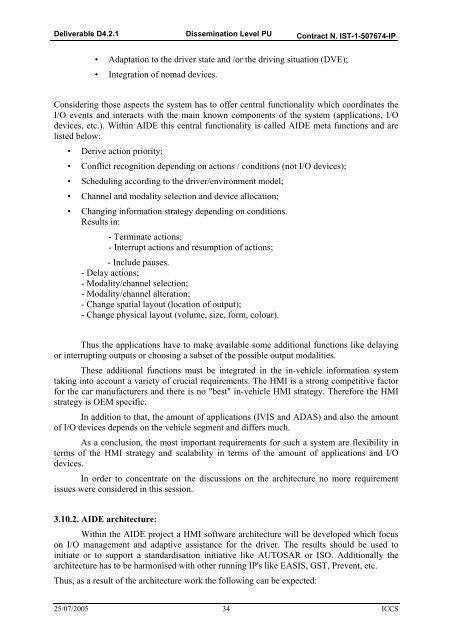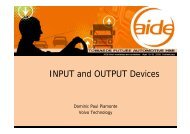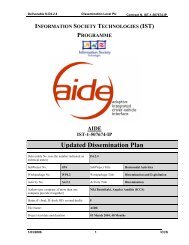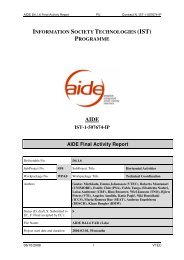download deliverable - AIDE
download deliverable - AIDE
download deliverable - AIDE
Create successful ePaper yourself
Turn your PDF publications into a flip-book with our unique Google optimized e-Paper software.
Deliverable D4.2.1 Dissemination Level PU Contract N. IST-1-507674-IP<br />
• Adaptation to the driver state and /or the driving situation (DVE);<br />
• Integration of nomad devices.<br />
Considering those aspects the system has to offer central functionality which coordinates the<br />
I/O events and interacts with the main known components of the system (applications, I/O<br />
devices, etc.). Within <strong>AIDE</strong> this central functionality is called <strong>AIDE</strong> meta functions and are<br />
listed below:<br />
• Derive action priority;<br />
• Conflict recognition depending on actions / conditions (not I/O devices);<br />
• Scheduling according to the driver/environment model;<br />
• Channel and modality selection and device allocation;<br />
• Changing information strategy depending on conditions.<br />
Results in:<br />
- Terminate actions;<br />
- Interrupt actions and resumption of actions;<br />
- Include pauses.<br />
- Delay actions;<br />
- Modality/channel selection;<br />
- Modality/channel alteration;<br />
- Change spatial layout (location of output);<br />
- Change physical layout (volume, size, form, colour).<br />
Thus the applications have to make available some additional functions like delaying<br />
or interrupting outputs or choosing a subset of the possible output modalities.<br />
These additional functions must be integrated in the in-vehicle information system<br />
taking into account a variety of crucial requirements. The HMI is a strong competitive factor<br />
for the car manufacturers and there is no "best" in-vehicle HMI strategy. Therefore the HMI<br />
strategy is OEM specific.<br />
In addition to that, the amount of applications (IVIS and ADAS) and also the amount<br />
of I/O devices depends on the vehicle segment and differs much.<br />
As a conclusion, the most important requirements for such a system are flexibility in<br />
terms of the HMI strategy and scalability in terms of the amount of applications and I/O<br />
devices.<br />
In order to concentrate on the discussions on the architecture no more requirement<br />
issues were considered in this session.<br />
3.10.2. <strong>AIDE</strong> architecture:<br />
Within the <strong>AIDE</strong> project a HMI software architecture will be developed which focus<br />
on I/O management and adaptive assistance for the driver. The results should be used to<br />
initiate or to support a standardisation initiative like AUTOSAR or ISO. Additionally the<br />
architecture has to be harmonised with other running IP's like EASIS, GST, Prevent, etc.<br />
Thus, as a result of the architecture work the following can be expected:<br />
25/07/2005 34 ICCS







